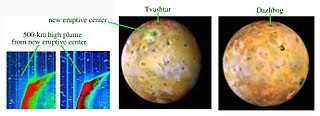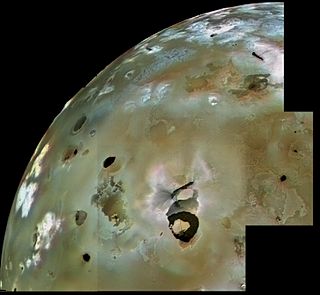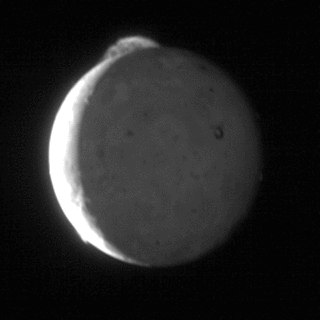 W
WVolcanism on Io, a moon of Jupiter, is represented by the presence of volcanoes, volcanic pits and lava flows on the moon's surface. Its volcanic activity was discovered in 1979 by Voyager 1 imaging scientist Linda Morabito. Observations of Io by passing spacecraft and Earth-based astronomers have revealed more than 150 active volcanoes. Up to 400 such volcanoes are predicted to exist based on these observations. Io's volcanism makes the satellite one of only four known currently volcanically active worlds in the Solar System.
 W
WAh Peku Patera is a patera, or a complex crater with scalloped edges, on Jupiter's moon Io. It is 85 kilometers in diameter and is located at 10.3°N 107°W. It is named after the Mayan thunder god Ah Peku. Its name was adopted by the International Astronomical Union in 2006. Ah Peku Patera is located on the south end of Monan Mons, north of which is Monan Patera. The eruptive centers Amirani and Maui can be found northwest, as well as Maui Patera. Gish Bar Patera is located toward the northeast. Ah Peku Patera was first detected by the spacecraft Galileo's Solid State Imager and Near-Infrared Mapping Spectrometer. It is considered an active hot spot.
 W
WAmirani is an active volcano on Jupiter's moon Io, the inner-most of the Galilean Moons. It is located on Io's leading hemisphere at 24.46°N 114.68°W. The volcano is responsible for the largest active lava flow in the entire Solar System, with recent flows dwarfing those of even other volcanos on Io.
 W
WDazhbog Patera is a patera on Jupiter's moon Io. Named after Dažbog in 1979, it has a largest size of approximately 120 km and is located 55.13°N 301.52°W. This volcano is difficult to differentiate from the other volcanoes and geological features in some images of Io. In images from the Voyager spacecraft, this caldera is quite prominent with its dark reddish floor with a darkish halo around the caldera. However, in Galileo images it is hard to tell where the volcano is. One would suspect that this would mean that it was inactive. But in July 1998, the Hubble Space Telescope using its NICMOS instrument detected a hotspot at Dazhbog.
 W
WEstan Patera is a patera, or a complex crater with scalloped edges, on Jupiter's moon Io. It is 95 kilometers in diameter and located at 21.53°N 87.59°W. It is named after the Hittite sun god Estan. Its name was adopted by the International Astronomical Union in 2006. It is located at the northern base of the 11-kilometer mountain Gish Bar Mons. Located west-northwest is Skythia Mons, and to the southwest is Monan Mons, at the northern and southern ends of which are Monan Patera and Ah Peku Patera.
 W
WGish Bar Patera is a patera, or a complex crater with scalloped edges, on Jupiter's moon Io. It is 106.3 by 115.0 kilometers and 9,600 km2 in area. It is located at 16.18°N 90.26°W. It is named after the Babylonian sun god Gish Bar. Its name was approved by the International Astronomical Union in 1997. It is located at the southern base of Gish Bar Mons, an 11-kilometer-high mountain. To the northeast is Skythia Mons, and to the east is Monan Mons, at the north and south ends of which are Monan Patera and Ah Peku Patera.
 W
WKanehekili Fluctus is a lava flow field on Jupiter's moon, Io. This fluctus is located in the sub-Jovian hemisphere at 17.68°S 33.56°W as shown in the picture on the right. Also in the picture is the Kanehekili volcanic center located at 18.21°S 33.6°W. This lava field covers roughly 34,500 square kilometres (13,300 sq mi). The hotspot was detected by the Galileo Solid State Imaging experiment (SSI) on orbits by Galileo.
 W
WLoki Patera is the largest volcanic depression on Jupiter's moon Io, 202 kilometres (126 mi) in diameter. It contains an active lava lake, with an episodically overturning crust. The level of activity seen is similar to a superfast spreading mid-ocean ridge on Earth. Temperature measurements of thermal emission at Loki Patera taken by Voyager 1's Infrared Interferometer Spectrometer and Radiometer (IRIS) instrument were consistent with sulfur volcanism.
 W
WMasubi is an active volcano on Jupiter's moon Io. It is located on Io's leading hemisphere at 49.6°S 56.18°W within a bright terrain region named Tarsus Regio. A volcanic plume has been observed at Masubi by various spacecraft starting with Voyager 1 in 1979, though it has not been persistent like similar Ionian volcanoes Amirani and Prometheus. Masubi is also notable for having one of the largest active lava flows on Io, with an additional 240 km (150 mi) flow forming between 1999 and 2007.
 W
WMaui Patera is a patera, or a complex crater with scalloped edges, on Jupiter's moon Io. It is about 38 kilometers in diameter and is located at 16.61°N 124.23°W. It is named after Māui, a Hawaiian demigod that sought fire from Mafuike. Its name was approved by the International Astronomical Union in 1979. It is located southwest of the eruptive center Maui, south of Euxine Mons, and southwest of the volcano Amirani. Due east are Monan Patera, Monan Mons, and Ah Peku Patera.
 W
WPele is an active volcano on the surface of Jupiter's moon Io. It is located on Io's trailing hemisphere at 18.7°S 255.3°W. A large, 300-kilometer (190 mi) tall volcanic plume has been observed at Pele by various spacecraft starting with Voyager 1 in 1979, though it has not been persistent. The discovery of the Pele plume on March 8, 1979 confirmed the existence of active volcanism on Io. The plume is associated with a lava lake at the northern end of the mountain Danube Planum. Pele is also notable for a persistent, large red ring circling the volcano resulting from sulfurous fallout from the volcanic plume.
 W
WPillan Patera is a patera, or a complex crater with scalloped edges, on Jupiter's moon Io. It is located at 12.34°S 243.25°W, south of Pillan Mons and west of Reiden Patera. It is named after the Araucanian thunder, fire, and volcano god. Its name was approved by the International Astronomical Union in 1997.
 W
WPrometheus is an active volcano on Jupiter's moon Io. It is located on Io's hemisphere facing away from Jupiter at 1.52°S 153.94°W.
 W
WRa Patera is an extraterrestrial volcano located on Io. An active volcano, it was first studied in 1979 via Voyager stereo imagery to determine its geology, topography, and the source of its eruptions. When first discovered, the mountain reached about one kilometer in height and featured numerous lava flows of either low viscosity or "high eruption rates". It is possibly a liquid sulfur-erupting volcano.
 W
WReiden Patera is a volcanic feature on Jupiter's moon Io. It was first detected by the Galileo SSI Team during the spacecraft Galileo's first orbit around Jupiter, initially detected as a hotspot. It was once thought that the activity there had stopped or waned below the limits of the spacecraft's Solid State Imager or Near-Infrared Mapping Spectrometer. However, it was noticed in 2002 that Reiden Patera has darkened considerably since the 24th orbit of Galileo. It has been spouting bright red pyroclastic deposits of its own. It is located at 13.4°S 235.45°W and is 70 kilometers in diameter. It is named after a Japanese thunder god. Asha Patera can be found to the east, and Kami-Nari Patera can be found to the north.
 W
WShango Patera is a patera, or a complex crater with scalloped edges, on Jupiter's moon Io. It is about 90 kilometers in diameter and is located at 32.35°N 100.52°W. It is named after the Yoruba thunder god Shango. Its name was approved by the International Astronomical Union in 2000. It is located north of Skythia Mons. To the southwest is the eruptive center Amirani, and to the southeast are Gish Bar Patera, Gish Bar Mons, and Estan Patera.
 W
WSurt is an active volcano on Jupiter's moon Io. It is located on Io's Jupiter-facing hemisphere at 45.21°N 336.49°W. Surt consists of an oblong volcanic pit, 75 by 40 kilometres in diameter, surrounded by reddish sulfur and bright sulfur dioxide deposits to its south and east. The volcano was first observed in images acquired by the Voyager 1 spacecraft in March 1979. Later that year, the International Astronomical Union named this feature after Surtr, a leader of the fire giants of Norse mythology.
 W
WTawhaki Patera is an active volcano on Jupiter's moon Io. It is located on Io's leading hemisphere at 3.32°N 76.18°W within the equatorial plains of western Media Regio. Tawhaki is an Ionian patera, a type of volcanic crater similar to a caldera, 49.8 kilometers (30.9 mi) wide and 550 meters (1,800 ft) deep.
 W
WThomagata Patera is a volcano on Jupiter's moon Io. It is located on Io's anti-Jupiter hemisphere at 25.67°N 165.94°W, to the east of the nearby active volcanoes Volund and Zamama. Thomagata is a kidney-shaped Ionian patera, a type of volcanic crater similar to a caldera, 56 kilometers (35 mi) long, 26 km (16 mi) wide, and 1.2–1.6 km (0.7–1.0 mi) deep. The volcano is currently inactive as a thermal hotspot has never been observed at Thomagata and the bright floor of the patera suggests that it is cold enough for sulfur dioxide and sulfur to condense. Thomagata is located near the center of a low, 100 km (62 mi) wide mesa. The edge of the mesa rises 200 meters (660 ft) above the surrounding plains, however the slope up to the edge of Thomagata Patera is unknown. If the floor of the patera is at the same level as the surrounding plains, the western slope of the mesa would have a grade of 2°. The morphology of this mesa and the pattern of faded lava flows along its slopes radiating away from Thomagata suggest that Thomagata Patera and the mesa that surrounds it may be a shield volcano, also called a tholus on Io. The irregular margin of the mesa and the lack of debris at the base of its basal scarp suggest that it was modified by sulfur dioxide sapping.
 W
WThor is an active volcano on Jupiter's moon Io. It is located on Io's anti-Jupiter hemisphere at 39.15°N 133.14°W. A major eruption with high thermal emission and a large, volcanic plume was observed during a Galileo flyby on August 6, 2001, when the spacecraft flew through the outer portions of the plume allowing for direct sampling. The eruption continued into Galileo's next flyby in October 2001. As seen during high-resolution images taken during the eruption, Thor consists of a series of dark lava flows emanating from a set of nearby volcanic depressions. Before the eruption, the area consisted of red-brown plains, composed of irradiated sulfur, typical of Io's mid- to high-northern latitudes and a set of yellow flows, possibly consisting of sulfur or silicate flows covered by diffuse sulfur deposits. During the New Horizons encounter in February 2007, Thor was still active, with the spacecraft observing thermal emission in the near-infrared and a volcanic plume at the volcano.
 W
WTupan Patera is an active volcano on Jupiter's moon Io. It is located on Io's anti-Jupiter hemisphere at 18.73°S 141.13°W. Tupan consists of a volcanic crater, known as a patera, 79 kilometers across and 900 meters deep. The volcano was first seen in low-resolution observations by the two Voyager spacecraft in 1979, but volcanic activity was not seen at this volcano until June 1996 during the Galileo spacecraft's first orbit. Following this first detection of near-infrared thermal emission and subsequent detections by Galileo during the next few orbits, this volcano was formally named Tupan Patera, after the thunder god of the Tupí-Guaraní indigenous peoples in Brazil, by the International Astronomical Union in 1997.
 W
WTvashtar Paterae compose an active volcanic region of Jupiter's moon Io located near its north pole. It is a series of paterae, or volcanic craters. It is named after Tvashtar, the Hindu god of blacksmiths. Tvashtar was discovered in IRTF images in November 26 1999, several hours after a Galileo flyby. Images taken with the ESO 3.6m telescope and its adaptive optics in September 1999 revealed the presence of faint hot spot. The outburst was studied by the Galileo spacecraft over several years. During this time, a 25-kilometre (16 mi) long, 1-to-2-kilometre high curtain of lava was seen to erupt from one patera, a lake of superheated silicate lava erupted in the largest patera, and finally a plume of gas burst out, rising 385 kilometres (239 mi) above Io and blanketing areas as far away as 700 kilometres (430 mi).
 W
WZamama is an active volcanic center on Jupiter's moon Io. This volcanic center erupted after the Voyager 1 flyby in 1979, making it one of the few planetary volcanoes known to have activated during this generation's lifetime. Further analysis and study by the Galileo spacecraft helped with the overall study of Io's volcanism. Galileo located it on Io at 21°N 173°W. Zamama has a fissure-fed-type flow that is 150 km (93 mi) long with temperatures of 1,100 K, and the volcanic center site has explosive and effusive eruption characteristics. The flow appears to be emanating from the Promethean-type volcano.